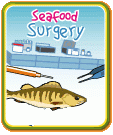
Contributed By: Science Museum of Virginia
Share This Experiment
Experiment Category:
Objective:
Discover the similarities and differences between a vertebrate and invertebrate by dissecting a perch and a crayfish.
What You Need:
- A perch (fresh or preserved)
- A crayfish (fresh or preserved)
- Diagrams from the Seafood Surgery Activity on Science Museum of Virginia web site: http://smv.org/pubs/SeafoodSurgery.pdf or refer to our online dissection: www.tryscience.org....
- Pointy, sharp scissors (smaller works better than larger ones)
- Forceps or tweezers
- A probe (a chopstick, or plastic fork or knife works)
- Gloves (optional)
- Newspaper to cover your working surface
To Do and Observe:
1. Obtain a perch and a crayfish, either from a biological company (they supply preserved specimens for a fee) or from a local market/seafood store. Be sure to ask for one that hasn't been cleaned. 2. Cover your work area with plenty of newspaper. 3. Print out the perch and crayfish diagrams (or have access to the online dissection on www.tryscience.org).
What's Going On:
In addition to exploring the general anatomy of perch and crayfish, there are some similarities and differences to note. Perch are vertebrates - they have a backbone - and crayfish are invertebrates - they have an exoskeleton (shell). Both the backbone and exoskeleton provide support and structure for each animal, but a perch's backbone grows with the perch, whereas the crayfish must molt, or lose, its shell when it gets too small and grow a new one. Another thing to notice is the difference between the perch and crayfish gills - where they're located and what they look like, even though they both filter oxygen from water. What other differences can you find?
Parent/Teacher Tips:
This can be a very rich and time consuming (and messy) activity! Having a good set of diagrams or dissection guides is essential, as well as a sharp pair of scissors - adult supervision is recommended.

Comments
Cool